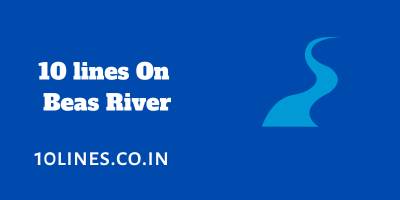10 lines On Beas River Are you a high school or college student looking for a ten-line essay on India’s famous river Beas? Below, we’ve presented three separate sets of facts regarding the Beas River. The three groups are based on the degree of comprehension of children, school pupils, and high school students.

10 lines On Beas River For Children And Students
Here you will find a wealth of information about Beas, including its origin, length, tributary rivers, cultural significance, and so on.
Beas is a river in northern India that runs through the states of Himachal Pradesh and Punjab. It is fed by tributaries and permanent snow channels that provide snowmelt. This river is a popular tourist destination in Manali. The river is significant since it provides a living for its inhibitors.
To learn more about the holy river Beas, read the entire article.
Set 1] 10 lines On Beas River For Children:
1] is a river located in northern India, alternatively spelt Biás or Bias.
2] The river rises 4,361 metres above sea level on the southern flank of Rohtang Pass in Kullu.
3] It has a total length of 470 kilometres and a drainage basin of 20,303 square kilometres.
4] The main tributaries of the Beas are the Bain, Banganga, Luni, and Uhal rivers.
5] The Beas River runs through the Indian states of Himachal Pradesh and Punjab.
6] The water from the river is used for drinking, irrigation, electricity production, agriculture, etc.
7] Manali, Kullu, and Amritsar are among the well-known cities that are situated along the river.
8] The major dams built on the Beas River are Pandoh Dam and Pong Dam.
9] The Beas River provides water to all of the cities, towns, and villages along its path.
10] The river travels through Himachal Pradesh for around 256 kilometres before entering Punjab.
Set 2] 10 lines On Beas River For School Students:
1] Beas River runs approximately 470 km from its source in the Himalayas to the river Sutlej.
2] The river has an average discharge of 499.2 m3/s, has also been known as Bias or Bejah.
3] The Beas River receives its water from tributaries and permanent snow channels that release snowmelt.
4] On the shores of the Beas River, the Vaishno Devi Temple is located in Kullu.
5] Heavy rainfall in the river basin causes severe floods during the monsoon season.
6] Beas Kund, the source of the revered Beas River, is regarded as the location where the great sage Vyas took his daily dip.
7] The primary cause of the Beas River’s pollution is the discharge of molasses from a sugar mill.
8] The tributaries Bain, Banganga, Luni and Uhal, Banner, Chakki, and Gaj enhances the flow of the river.
9] The river is also a vital location for the endangered Indus River Dolphin (IRD).
10] During Alexander’s invasion of India, Beas was one of the waterways that caused issues.
Set 3] 10 lines On Beas River For College Students:
1] One of Punjab’s rivers, Bias, is referenced in relation to Sapta-Sindhu in the revered Rig-Veda.
2] The river originates at Beas Kund in the Himalayan state of Himachal Pradesh.
3] The name “Beas” as it is used today is believed to be a version of the name “Vyas,” which is the name of Veda Vyasa.
4] The river bears the same name as the town of Beas, which is located on its banks in Punjab’s Amritsar district.
5] Beas Falls in the Sutlej River at the southwest corner of Punjab’s district of Kapurthala.
6] The Sutlej continues into the Punjab region of Pakistan where it merges with the Chenab River to create the Panjnad River.
7] Visitors to Manali, a small tourist town located along the banks of this gushing Himalayan River, will find Beas to be a natural attraction.
8] The river plays an important role in the development of a unique culture among the people who live along its banks.
9] The Beas Conservation Reserve is a 185-kilometre section of the Beas River in the state of Punjab.
10] The Beas River is viewed as a lifeline for Manali (Himachal Pradesh) based on the amount of its use for various purposes.
Folks, thank you for taking the time to read the river Beas essay. The information above should be valuable to you, and we hope you enjoyed reading it. We made an effort to deliver this knowledge in a straightforward and easy-to-remember language. These 10 lines on Beas River material may be used for project work, homework, test preparation, speeches, and other purposes.